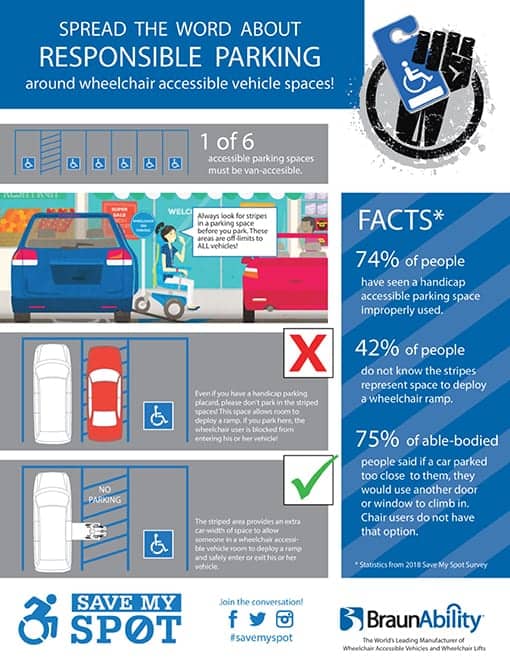A survey released from BraunAbility as part of the “Save My Spot” campaign reveals that 74% of people have personally seen a handicap accessible parking space being improperly used.
Parking limitations cause major challenges for wheelchair users, but the study indicates that lack of understanding about handicap accessible parking on the part of other drivers may be the underlying issue, according to the survey, released as part of BraunAbility’s “Save My Spot” campaign to help educate the public about the meaning and importance of handicap accessible parking, notes a media release from the Winamac, Ind-based company.
BraunAbility shares five facts drivers may not know regarding handicap accessible parking:
1) The striped lines next to a handicap accessible parking space have a specific purpose.
Striped lines next to a handicap accessible parking space primarily indicate it is reserved for a wheelchair-accessible vehicle, yet 42% of respondents were unaware of this purpose. Among the respondents, 15% were unaware that the lines had a specific meaning at all.
2) There is a difference between handicap accessible parking for cars and wheelchair-accessible vans.
Many handicap accessible parking spaces are reserved for people with a disability who are not driving a wheelchair accessible vehicle. However, when the parking sign says, “Accessible Vans,” it is reserved for wheelchair accessible vehicles only.
“People with disabilities need much more room when they arrive in a wheelchair accessible van,” says Chris Carlisle, vice president of marketing at BraunAbility, in the release.
“Van accessible spaces are wider than regular handicap accessible parking spaces, offering room for people to lower their ramp and enter and exit their vehicle. In our survey, we asked able-bodied people what they would do if a car parked too close to them, and 75 percent said they would climb through a window or opposite door to get in. Wheelchair users don’t have this option and need the extra space.”
Van accessible spaces are easily identified by a blue-striped access aisle on the passenger side.
3) Some people have “hidden disabilities” that may not look like they need a handicap accessible spot, but they do.
Twenty-seven percent of survey participants did not know handicap accessible parking spots were also designated for hidden disabilities like deafness or a recent knee injury.
“There are no visible supports such as a cane or wheelchair for hidden disabilities, but that doesn’t mean the person parking there is misusing the spot,” Carlisle adds.
4) Businesses are required to have a certain number of handicap accessible spots.
The number of handicap accessible parking spaces required depends on the total number of parking spaces in the lot, but at least one in every six handicap accessible spaces must be van accessible, according to the Americans with Disabilities Act.
5) Wheelchairs continue to increase in size, requiring more room to maneuver in and out of vehicles.
“Chairs continue to get bigger, which can result in maneuverability challenges for chair users as they try to get in and out of vehicles,” Carlisle shares.
He adds that the BraunAbility Pacifica, for example, was designed to offer a large amount of interior space, as well as easy entry and exit. Vehicles like this are larger and require extra space in a parking spot for the wheelchair user to access a fully deployed ramp.
As part of National Mobility Awareness Month in May, BraunAbility is partnering with dealers across the United States and Canada to give away “Save My Spot” kits. The kits include a window sticker, “Save My Spot” “parking tickets,” and other items to help spread the message about proper usage of handicap accessible parking, per the company.
[Source(s): BraunAbility, PR Newswire]






I live in Colorado. When I moved in to my apartment there was 1 handicap spot for our building and it was not close to my entrance. I asked management if they could put a spot for me in front of my entrance. They said I needed to have paperwork from my doctor saying I needed the spot. I feel like since it was put in for me and I provided the paperwork that it should be able to be reserved specifically for me with the apartment number on the sign. Other people keep parking in the spot and I have to walk at least 2-3 blocks to get to my apartment. What does the law say about that. I have searched and searched and I can’t find anything.
Get a reasonable accommodation form from the apartment manager. Get your doctor to fill it out saying you need an assigned parking space within 100ft or the closest spot to the entrance of your building. They will put a reserved sign in and if people park there you can legally have them towed. I would give a grace period with post-it notes for a week if someone parks there. Let them know it’s reserved and if they park there again, you will have them towed. Take pictures, video whatever; because they may try and sue you over an illegal tow. I’ve been in your situation, I had a sign put in; and I had to have vehicles towed away.
#2 is false. From https://www.access-board.gov/guidelines-and-standards/buildings-and-sites/about-the-ada-standards/guide-to-the-ada-standards/chapter-5-parking
Must van accessible spaces be restricted to van use?
No. The required “van-accessible” designation is informative, not restrictive, in identifying those spaces that are better suited for van use and does not restrict the use of spaces to vans only. State or local codes and regulations may require additional verbiage, but the ADA Standards do not. Additional content on van designation signs can recommend that car drivers not use the space unless no other accessible parking space is available
My Neighbor has 2 cars and 1 has handicap plates she keeps parking both her cars across the street but she has a drive way and the town gave her her own handicap parking space in front of her house that’s she is not parking her car in been empty for 3 days now today she is letting someone else use the none handicap car and that person is parking in the handicap spot and she still has her handicap car in front of my house witch is to houses down and across the street and there is already no parking on my block can she do this ?
According to Janis Kent, FAIA, CASp, an architect who specializes in accessibility, parking in general is guided by the Americans with Disabilities Act (ADA). However, she says, individual states have more specific requirements, and even cities themselves may sometimes have requirements above and beyond what the states themselves have.
Kent says that In the state of California for example, these requirements are in the state building code. However, individuals may go to local building departments to find more detailed information.
You might find more information about this and related issues on Kent’s blog. One example specific to van accessible parking spaces is here https://steppingthruaccessibility.com/the-van-accessible-parking-space-what-does-it-need/
—Editor
I am in PA and my new apartment complex is telling me it is illegal to specify a parking space for a specific apartment.
My current apt complex does this in PA
I see some people say it is not legal to do but I need to know if it is in PA
Thanks!
According to Janis Kent, FAIA, CASp, an architect who specializes in accessibility, parking in general is guided by the Americans with Disabilities Act (ADA). However, she says, individual states have more specific requirements, and even cities themselves may sometimes have requirements above and beyond what the states themselves have.
Kent says that In the state of California for example, these requirements are in the state building code. However, individuals may go to local building departments to find more detailed information.
You might find more information about this and related issues on Kent’s blog. One example specific to van accessible parking spaces is here https://steppingthruaccessibility.com/the-van-accessible-parking-space-what-does-it-need/
—Editor
I live on a apartment, have 1 handicap spot in my building, someone’s keeps there car parked there all the time and never moves it, is this legal
Have the same problem at my apt complex and the resident office does NOTHING about it. Can’t tow without them signing off on it and the girl keeps parking there. Habitually.
What can be done so the apt complex also adheres to this law?
According to Janis Kent, FAIA, CASp, an architect who specializes in accessibility, parking in general is guided by the Americans with Disabilities Act (ADA). However, she says, individual states have more specific requirements, and even cities themselves may sometimes have requirements above and beyond what the states themselves have.
Kent says that In the state of California for example, these requirements are in the state building code. However, individuals may go to local building departments to find more detailed information.
You might find more information about this and related issues on Kent’s blog. One example specific to van accessible parking spaces is here https://steppingthruaccessibility.com/the-van-accessible-parking-space-what-does-it-need/
—Editor
One of our condo owners has an assigned parking spot in addition to his garage. He parks in our only handicapped spot for most of the time. He does have handicap plates however, has same number of spots for him to park his vehicles as he rest of us.He owns 3 vehicles and parks 2 of them in driveway of family friend who owns a duplex. If someone with a handicap visits and he is parked in our only handicap spot, the must park on the street or in spot provided in open area for each owner. This person climbs ladders, does work on roofs and landscape and seems very mobile, and yet acts as if our one spot primarily is for his use.
IS IT LEGAL FOR A HAICAP SPACE TO BE RESERVED FOR A SPECIFIC INDIVIDUAL BY NAME?
Has anyone answered you or have you found out? I am in PA and asking the same question.
My old apartment did it for us but the new one is refusing
According to Janis Kent, FAIA, CASp, an architect who specializes in accessibility, parking in general is guided by the Americans with Disabilities Act (ADA). However, she says, individual states have more specific requirements, and even cities themselves may sometimes have requirements above and beyond what the states themselves have.
Kent says that In the state of California for example, these requirements are in the state building code. However, individuals may go to local building departments to find more detailed information.
You might find more information about this and related issues on Kent’s blog. One example specific to van accessible parking spaces is here https://steppingthruaccessibility.com/the-van-accessible-parking-space-what-does-it-need/
—Editor
I was told that in California a mobility van can take up two spaces of regular parking to accomadate the side loading wheelchair. Is this true?
According to Janis Kent, FAIA, CASp, an architect who specializes in accessibility, parking in general is guided by the Americans with Disabilities Act (ADA). However, she says, individual states have more specific requirements, and even cities themselves may sometimes have requirements above and beyond what the states themselves have.
Kent says that In the state of California for example, these requirements are in the state building code. However, individuals may go to local building departments to find more detailed information.
You might find more information about this and related issues on Kent’s blog. One example specific to van accessible parking spaces is here https://steppingthruaccessibility.com/the-van-accessible-parking-space-what-does-it-need/
—Editor
I live in an apartment complex with a handicap parking space that also has the handicap emblem painted on the ground. This same parking space also has a sign that says “reserved parking violators will be towed at owners expense”. I have seen vehicles displaying a placard park in this space and get towed. Is this proper or legal?
They can legally assign parking spaces and does not violate ADA laws. My apartment had to do it for me when my rude neighbor kept taking my spot,because he refused to turn in his paperwork for his own.
I now have a sign with reserved handicap violators will be towed with my address. He thinks he can park there, but he has been towed!
Can you tell me what State you are in? I am looking for information for PA
Thank you
According to Janis Kent, FAIA, CASp, an architect who specializes in accessibility, parking in general is guided by the Americans with Disabilities Act (ADA). However, she says, individual states have more specific requirements, and even cities themselves may sometimes have requirements above and beyond what the states themselves have.
Kent says that In the state of California for example, these requirements are in the state building code. However, individuals may go to local building departments to find more detailed information.
You might find more information about this and related issues on Kent’s blog. One example specific to van accessible parking spaces is here https://steppingthruaccessibility.com/the-van-accessible-parking-space-what-does-it-need/
—Editor
I live in an apartment complex that has a handicapped parking sign with the painted emblem on the ground. This same parking spot also has a sign saying ‘reserved parking’ violators will be towed at owners expense. They have towed vehicles with handicapped placards. Is that ok?
According to Janis Kent, FAIA, CASp, an architect who specializes in accessibility, parking in general is guided by the Americans with Disabilities Act (ADA). However, she says, individual states have more specific requirements, and even cities themselves may sometimes have requirements above and beyond what the states themselves have.
Kent says that In the state of California for example, these requirements are in the state building code. However, individuals may go to local building departments to find more detailed information.
You might find more information about this and related issues on Kent’s blog. One example specific to van accessible parking spaces is here https://steppingthruaccessibility.com/the-van-accessible-parking-space-what-does-it-need/
—Editor
I live in N>J> and have lived in two different apt. complexes and they have apt numbers on them so only the resident can park there. Another complex said they would put one up for me but any handicap could park there. I had to pay extra for a reserved spot just for me to part in front of my apartment as I have handicap plates.
I’m the driver for my dad who uses a walker and the license plate has the wheelchair icon. The car belongs to mom as dad doesn’t drive. My dad needs the striped space for widening the door and the walker. I understand why the zone is marked for wheelchair, but the walker-users need as much space. I was a medical professional for over 24 years and there isn’t enough awareness of how difficult it is for the elderly using a walker.
A person with a handicap placard who does not used a wheel chair insist on parking in a spot that is marked for Vehicle with side ramp only, what can be done about this matter he drives a regular vehicle.
This location is a Military Medical Center.
He may not be aware of the difference. Would getting his plate number and having the facility track him down to explain the differences be doable?
The markings for side ramps are allowances. Not “just for”. It gives room for people in cars, trucks, vans, etc to get out with a wheelchair, walker, crutches, cane, etc without being slammed up against about vehicle as well.
Not everyone can afford nor desire a wheelchair accessible van. But this doesn’t diminish ther need for access to room to get your wheelchair out of said vehicle without worrying about scraping up their paint.
I have a handicapped placard and when I park there for work, I’m told by the principal that I can not park there, that it’s designated for the parents of handicapped stude ts, to drop off their children to school. isn’t she violating the law? what would she faced with if I took this further.
ADA requires that you are also have access to handicapped parking as long as you have a handicapped placard or plate. I would suggest getting on the internet and pulling up the ADA laws and submitting it to your work place. In the end if you can not get satifaction you will have to turn them in using the phone number provided on the ADA information sheet.
I understand this situation, we see a couple hundred patients per day at our imaging facility, we have two handicap spaces that can be wheelchair accessible these spots can be used by multiple patients throughout the day, however some employees take these spots for the ENTIRE DAY, none of these employees use any devices to help walk, and there are regular spots closer to the front door available.
According to Janis Kent, FAIA, CASp, an architect who specializes in accessibility, parking in general is guided by the Americans with Disabilities Act (ADA). However, she says, individual states have more specific requirements, and even cities themselves may sometimes have requirements above and beyond what the states themselves have.
Kent says that In the state of California for example, these requirements are in the state building code. However, individuals may go to local building departments to find more detailed information.
You might find more information about this and related issues on Kent’s blog. One example specific to van accessible parking spaces is here https://steppingthruaccessibility.com/the-van-accessible-parking-space-what-does-it-need/
—Editor